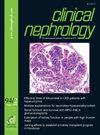在神经源性下尿路功能障碍患者中应用神经网络模型改进肾小球滤过率估算。
IF 1
4区 医学
Q3 UROLOGY & NEPHROLOGY
引用次数: 0
摘要
背景以前的研究表明,基于肌酐(Cr)的肾小球滤过率(GFR)估算方程--包括新的慢性肾脏病流行病学肌酐(CKD-EPIcr)无种族方程和为中国人群开发的估算肾小球滤过率(eGFR)方程--在神经源性下尿路功能障碍(NLUTD)患者中表现不佳,这限制了它们在所有人群中检测GFR水平变化的临床应用。目的开发一种基于多层感知器(MLP)的神经网络模型,用于评估中国 NLUTD 患者的 GFR,并比较其与基于 Cr 的中国人多元线性回归方程和无种族的 CKD-EPIcr 方程的诊断性能。方法采用锝-99m标记的二乙烯三胺五乙酸(99m锝-DTPA)双血浆样本法评估参考GFR(rGFR)。结果与基于 Cr 的 GFR 方程相比,基于 MLP 的模型在评估 GFR 差值、绝对差值、精确度和准确度方面都有显著改善。此外,与 rGFR 相比,我们发现基于 MLP 的模型提供了可接受的准确度(大于 85%,与 rGFR 的偏差在 30% 以内)。本文章由计算机程序翻译,如有差异,请以英文原文为准。
Application of improved glomerular filtration rate estimation by a neural network model in patients with neurogenic lower urinary tract dysfunction.
BACKGROUND
Previous studies have indicated that creatinine (Cr)-based glomerular filtration rate (GFR) estimating equations - including the new Chronic Kidney Disease Epidemiology creatinine (CKD-EPIcr) equation without race and the estimated glomerular filtration rate (eGFR) equation developed for the Chinese population - displayed suboptimal performance in patients with neurogenic lower urinary tract dysfunction (NLUTD), which limited their clinical application for detecting changes in GFR levels in all cohorts.
OBJECTIVE
To develop a neural network model based on multilayer perceptron (MLP) for evaluating GFR in Chinese NLUTD patients, and compare the diagnostic performance with Cr-based multiple linear regression equations for Chinese and the CKD-EPIcr equation without race.
DESIGN
Single-center, cross-sectional study of GFR estimation from serum Cr, demographic data, and clinical characteristics in Chinese patients with NLUTD.
PATIENTS
A total of 204 NLUTD patients, from 27 different geographic regions of China, were selected. A random sample of 141 of these subjects was included in the training sample set, and the remaining 63 patients were included in the testing sample set.
METHODS
The reference GFR (rGFR) was assessed by the technetium-99m-labeled diethylenetriaminepentaacetic acid (99mTc-DTPA) double plasma sample method. A neural network model based on MLP was developed to evaluate GFR in the training sample set, which was then validated in the testing sample set and compared with Cr-based GFR equations.
RESULTS
The MLP-based model showed significant performance improvement in evaluating the difference, absolute difference, precision, and accuracy of GFR estimation compared with the Cr-based GFR equations. Additionally, compared with the rGFR, we found that the MLP-based model provided an acceptable level of accuracy (greater than 85%, which was within a 30% deviation from the rGFR).
CONCLUSION
The MLP-based model offered significant advantages in estimating GFR in Chinese NLUTD patients, and its application could be suggested in clinical practice.
求助全文
通过发布文献求助,成功后即可免费获取论文全文。
去求助
来源期刊

Clinical nephrology
医学-泌尿学与肾脏学
CiteScore
2.10
自引率
9.10%
发文量
138
审稿时长
4-8 weeks
期刊介绍:
Clinical Nephrology appears monthly and publishes manuscripts containing original material with emphasis on the following topics: prophylaxis, pathophysiology, immunology, diagnosis, therapy, experimental approaches and dialysis and transplantation.
 求助内容:
求助内容: 应助结果提醒方式:
应助结果提醒方式:


